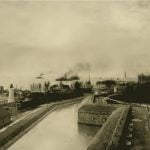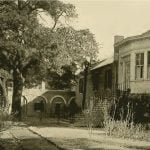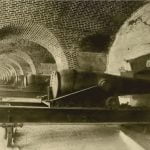
Morning bugle call, the evening gun, grey ships of war stealing in from a misty sea with long plumes of soft black smoke, military uniforms on the streets and trig bright houses are, probably, the average civilian’s impressions of a stay at Old Point Comfort where is located Fort Monroe. “Fort ” or “Fortress,” for the place changes its sex indifferently according to the state of mind of the speaker, it probably satisfies the popular conception of a mighty stronghold of defense more completely than any other such establishment in the United States. And, indeed, it is a great defensive work, guarding one of the most vital points of entrance in this country, menacing hostile approach to the very capital of the country itself.
At the southern limit of the western shore of the Chesapeake Bay is a long sandy peninsula whose extremity in times of flood is cut off from the mainland by a narrow wash of water, and on this sometimes isolated tip of the peninsula is situated Fort Monroe. The grounds of the reservation, which includes all of the residence portion of the little community, too, embrace about 280 acres of almost always dry land. The walls of the fort itself encircle the greater part of this number of acres.
From the summit of these walls one looks out upon a wide prospect of waters. To the south is Hampton Roads, into which empty the waters of the James, the Elizabeth and the Nansemond Rivers. To the east lies the wide expanse of the lower Chesapeake Bay, giving access to the Potomac and the network of other rivers, which the bay holds as tributaries. From all directions except from the west pours in upon Old Point a vivifying draught of pure salt air. From the west, from the mainland, come all manner of humidities, unpleasantness and mosquitoes, but this is only one of four points of the compass.
It is a healthy place, this Old Point Comfort, so healthy, indeed, that in a grave government report of 1877 the army surgeon at the post tells his superiors in Washington that there is a legend in the army that the air of the place conduces to fecundity in the families stationed there. He adds that from his own professional practice and his observation of the number of children playing in the streets he believes that there is more than fancy in the idea!

The visitor to Fort Monroe will almost invariably come by water, though there is a roundabout way of reaching the post by way of trolley from Newport News – through quaint old Hampton, past Hampton Institute and over a long trestle to the reservation. He will see, first, on putting foot upon the wharf and fighting off the hungry hordes of hack men and baggage smashers, the red walls of a popular hotel. To the right is a triangular park, on the far side of whose spread of green is a row of modem cottages of pretentious architecture, which are given over to the superior officers stationed at the post. Beyond the roofs of these can be seen, in glimpses, the battlements of the old fort. Perhaps our visitor will penetrate on farther back into the grounds, along the winding main street, until he comes to the main entrance to the fort, faced by an inn much used by officers and the military set. Here there are cottages, of less imposing aspect than those facing the sea, which are given over to the younger officers and their families. Here also one has his first clear view of the fort walls.
Without a doubt it is recollection of the moat that one carries away from Fortress Monroe, primarily. This broad band of water, encircling the high, grey old walls of the place, appeals strongly to one’s romantic sense. Ho, warder! to the drawbridge! And all that sort of thing. There is a drawbridge, too, five of them, in fact, at the five entrances to the fort. So, ho, for the drawbridge and a view inside the fort!
The visitor who crosses the narrow way leading across the moat and penetrates to the interior of Fortress Monroe will not be greatly impressed by show of military works. These are all quietly and modestly ready in the background, somewhere. He will find himself in a charming sort of park, which strongly suggests the tropics in its luxuriance of foliage of all kinds. Indeed the air of Old Point, for some reasons, supports tropical plant growth that will not live in the countryside immediately adjoining. One of the effective sights that the visitor sees in the fort are the clumps of fig trees which are to be found, and there are to be found, too, magnolia and rhododendron and crape myrtle.
There is a large parade ground, flanked on the east and north by long barracks. The rest of the grounds, not including the casemates, is given over to residences, to various storehouses and to a building of the Coast Artillery School which has been located at Monroe since 1867.

The casemates of the old fort are used as residences for married private soldiers and for other purposes, not transparently military. The long rows of heavy cannon once to be seen here are to be found no more, their place being taken by modern batteries elsewhere.
There is to be seen the casemate in which Jefferson Davis, president of the Confederate States, was confined after the working out of the destiny of the Lost Cause. It is not different from its neighbors, and is an inconspicuous little compartment in a wall with an ornamental little two post doorway and one window. Many curious visitors stop before it.
Old Point Comfort and all of this section of the lower Chesapeake have seen many strange visitors and cargoes in the Past. Doughty old Captain John Smith came to Hampton Roads and wrote about what he saw with that wealth of picturesque detail, which those old chroniclers loved to pour forth. The name Point Comfort itself came from the circumstance that Smith was cast into this Hampton Roads on the wings of a storm at sea and that he hailed the first strip of solid land that he saw as a comfort, indeed. At an early period a settlement was made here, as a subsidiary of the Jamestown colony, and, as early as 1611, a fort was built on the point as a defense against Indians and freebooting marauders of buccaneer type. The fort was armed and known as Fort Algernon, in honor of Lord Algernon Percie, one of the directors of the Virginia Company. The greatest fort of the country was once called Algernon!
This little fortification was not of long life, however. It was maintained for a few years by the Jamestown colony but went into decay after the failure of its parent. The strategic value of the Point as a place for defense was not lost sight of, however, in any succeeding generation, though the place was not called into service for many years.
The foundations of Fortress Monroe were laid in 1819, and the works were carried forward actively for ten years. The plans were drawn by the famous Bernard, onetime aide-de-camp of the first Napoleon, and one of his leading engineers. It was Bernard’s ambition to construct in the United States (he came to the United States in 1816 and immediately entered the employ of the government) one great fortress like the works of Antwerp, in the fortification of which he had a large share. Fort Monroe, named in honor of the president who did so much to make sure that the coast defenses of the country should be adequately founded, was the result of this vision.
It is to be seen that the life of the present fortification begins after the War of 1812, but the military history of the vicinity of Fort Monroe prior to that time is full of interest.
During the Revolution the mouth of the Chesapeake was guarded by British cruisers and a rigorous blockade was maintained. Despite this, during the war no less than 248 privateers were fitted out in the waters of the Chesapeake and managed to gain the high seas by eluding the vigilance of the patrol beyond the capes.
In 1779 General Leslie sailed from New York with 3000 of His Majesty’s troopers to land upon the peninsula not far from the site of Fort Monroe and there to await orders from Lord Cornwallis, who was in North Carolina. He entered Hampton Roads and took Norfolk and Portsmouth, fortifying the latter place as a base for future operations. After some weeks of inactivity, he reembarked and sailed to reinforce Cornwallis at Charleston. In the following year Clinton ordered the traitor Arnold with 50 sail and 1600 soldiers to replace Leslie.
The Arnold expedition proceeded up the James River in 1781 and set the torch to the public buildings of Richmond. After pillaging Petersburg, it returned to Portsmouth and threw up strong entrenchments. Lafayette attempted to stay this destroying band but had not force enough of his own and did not receive expected reinforcement. The fleet which had been sent to augment his numbers was engaged by the British under Admiral Arbuthnot off the capes and compelled, after a hot engagement, to withdraw to Newport. The English thus retained their hold on Hampton Roads and were enabled to send additional forces to General Arnold under General Phillips. In April the combined forces under Arnold moved again up the James River, burning and pillaging.
Cornwallis occupied Portsmouth shortly after this, but soon again moved to Yorktown, where he threw up huge entrenchments, the outlines of which are plainly discernible at the present day. In September 1781, the French under Comte de Grasse were successful in entering the Chesapeake to cooperate with Washington, Lafayette and Rochambeau. The British fleet under Admiral Graves sturdily contested the capes, but was forced to surrender the hold, which it had maintained so effectively. In the ensuing month occurred the historic surrender of Cornwallis.
During the War of 1812, a British order in council declared the Chesapeake to be in a state of blockade, and in 1813 Rear Admiral Cockburn of His Majesty’s Navy was sent to Lynnhaven Bay, near Norfolk. The Americans had a large flotilla in Hampton Roads, and had constructed Forts Norfolk and Nelson on the Elizabeth River near Norfolk and had thrown up entrenchments on Craney Island, these dispositions all being under the direction of Brigadier General Robert B. Taylor.
At daybreak of June 22, 1813, a determined attack was made by the British under Cockburn from land and sea, which was repulsed. Three days later quiet Hampton was captured after a gallant defense by an inadequate garrison and the town pillaged in barbaric fashion. Soon after, Cockburn withdrew to the coasts of South Carolina and Georgia, but resumed his operations in the lower Chesapeake March 1, 1814. In July 1814, he was largely reinforced and with a combined land and naval expedition commenced that march up the Chesapeake, which culminated in the sacking of Washington and the final repulse of the expedition at Fort McHenry. This was the last important engagement of the War of 1812.

During the Civil War Fortress Monroe saw stirring scenes, though it had no very active part in any of them. In October 1861, Hampton Roads off the fort was the rendezvous for great land and naval forces under Admiral Dupont and General Sherman designed to capture Hilton Head. In the January following another great force was brought together here for operations on the Carolina coast. In the spring of 1862 McClellan’s army arrived at Old Point and went to Yorktown.
In March of 1862 occurred in Hampton Roads the episodes of the Merrimac. A watcher on the walls of Fort Monroe would have seen this queer, square vessel, covered with railroad iron, sailing down the blue waters. He might have seen the sinking of the Cumberland with the greater part of her crew despite her desperate, impotent efforts against this new kind of adversary. He might have witnessed the destruction of the Congress by fire and the partial disabling of the Minnesota. He might have heard in the old fort that night the barrack room gossip of the new giant and whispers of the expected arrival of a United States champion, which was to take up the gage of combat. The next day he might have seen from the ramparts the struggle between the Merrimac and the Monitor, which ushered in a new chapter in naval warfare and began the era of the steel clad knight of the seas.
Later Old Point Comfort became the base of operation of the Army of the James.
In 1893, during the celebration of the Columbian Exposition, Hampton Roads was the rendezvous under the guns of old Monroe for the vessels of all of the nations of the world. The old fort sees the most important maneuvers of the United States navy of today.
Discover more from Access Genealogy
Subscribe to get the latest posts sent to your email.
